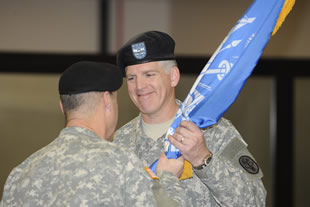Col. Russell Coleman Assumes USAMMDA Command
The reign of the U.S. Army Medical Materiel Development Activity was handed over to Col. Russell E. Coleman Jan. 21 here at Fort Detrick, Md.
The U.S. Army Medical Research and Materiel Command along with USAMMDA guests welcomed the incoming commander. He accepted the colors from reviewing officer and U.S. Army Medical Research and Materiel Command and Fort Detrick commander Maj. Gen. James Gilman.
Outgoing Commander, Col. Brian J. Lukey served three years and will be the new the Military Deputy to the Principal Assistant for Research and Development at the MRMC headquarters.
Gilman thanked both commanders for their work.
"Colonel Lukey had clear, achievable objectives and has accomplished them," said Gilman. He said Coleman is the best qualified person to take over. "He has a proven track record."
Lukey made his last remarks.
"This change of command ceremony isn't about me or about Col. Russell Coleman but it's about the unit of people who make up USAMMDA; contractors, civilians, military, government agencies and other institutions," said Lukey. "It has been an honor and I am humbled to have been the commander of USAMMDA. It's the people who make your job fun."
Coleman is very familiar with the command. He was previously the deputy commander of USAMMDA. He started his career at the Walter Reed Army Institute of Research in the Department of Entomology. Coleman's subsequent assignments included an internship as a USAMRMC Technology Staff Officer at the Pentagon; Chief of the Department of Vector Assessment at the U.S. Army Medical Research Institute of Infectious Diseases, Fort Detrick, Md.; Commander of the 105th Medical Detachment, Fort Lewis, Wash.; Chief of the Department of Entomology at the Armed Forces Research Institute of Medical Sciences, Bangkok, Thailand; and Director of the Diagnostics System Division at USAMRIID. In 1995, Colonel Coleman deployed to Zaire as part of a World Health Organization team responding to an Ebola Virus outbreak, and in 2003 he deployed to Operation Iraqi Freedom as the Chief of the Preventive Medicine Section of the 520th Theater Army Medical Laboratory. Upon his return from Iraq, Coleman's last assignment was the Director of the Division of Entomology at the WRAIR before becoming the USAMMDA deputy.
"This is an easy transition," said Coleman. "However, today's event is a mixed blessing. My friend, my mentor, my confidant is leaving me but I am truly excited about my new position. My expectations are high. I want our team to remember we have a critical mission to get medical products to the warfighter; whether it's freeze-dried plasma, an improved first aid kit or a one-hand tourniquet."
USAMMDA is organized around two major project management activities and four support divisions. The Pharmaceutical Systems Project Management Division centrally manages the development and acquisition of drugs, vaccines, diagnostics, repellents, blood products, and resuscitative fluids, including leveraging USAMRMC laboratories with domestic and foreign pharmaceutical companies. The Medical Support Systems Project Management Division supports the Warriors' medical materiel needs by analyzing functional requirements, evaluating products, and developing technical and program strategies for product acquisitions. The Quality Office focuses on the support of the sponsor's regulatory requirements. DRAC provides regulatory support from research through advanced development and acquisition stages. The Medical Affairs and Pharmacovigilance Division addresses and coordinates all safety issues for OTSG-sponsored studies. The Administrative Services Division provides overall management, administrative, budgeting, and information technology support to ensure the smooth function of the operational divisions.















